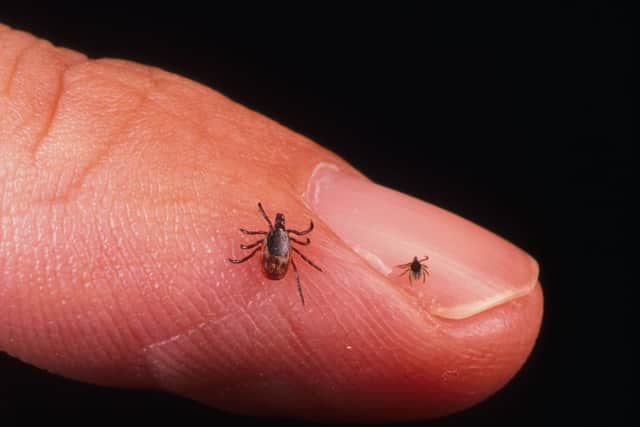All you need to know about Lyme disease and the danger of tick bites
and live on Freeview channel 276
It’s also important to know what to do if bitten by a tick to prevent further cases of Lyme disease this year.
There are around 3,000 new cases each year in England and Wales, according to Public Health England.
Advertisement
Hide AdAdvertisement
Hide AdCases may be up to three times higher than estimated as this figure is based on positive blood test results and excludes all clinical diagnoses of Lyme disease, including people diagnosed based on the presence of a Lyme disease rash.
Lyme disease has been attracting increasing political and media attention over the past few years.
Media interest in Lyme disease continues to grow particularly since celebrities such as John Caudwell, Yolanda Foster, Ally Hilfiger, Avril Lavigne, Matt Dawson, Justin Bieber, Shania Twain, Martine McCutcheon and Nell McAndrew have been talking publicly about their struggles with Lyme disease.
Here is more information about tick bites and Lyme disease.
What is Lyme disease?


Lyme disease is a bacterial infection that can be spread to humans by infected ticks.
Advertisement
Hide AdAdvertisement
Hide AdIt’s the most common tick-borne infectious disease in the northern hemisphere and there are multiple strains of the bacteria.
Lyme disease is endemic in many parts of the United Kingdom, particularly in woodland or heath-land areas but disease carrying ticks can also be found in cities and gardens.
In 2016, the Big Tick Project discovered that a third of dogs checked in a study had ticks attached, which their owners did not know about.
How is Lyme disease transmitted?
Transmission of Lyme disease can occur when bitten by an infected tick.
Advertisement
Hide AdAdvertisement
Hide AdOther modes of transmission include congenital transmission from mother to baby.
Blood, tissue and organ donation, along with sexual transmission are all cause for concern.
The Centers for Disease Control and Prevention said: "Although no cases of Lyme disease have been linked to blood transfusion, scientists have found that the Lyme disease bacteria can live in blood that is stored for donation."
What are the symptoms of Lyme disease?
According to the NHS website, a circular or oval shape rash around a tick bite can be an early symptom of Lyme disease in some people.
Advertisement
Hide AdAdvertisement
Hide AdThe rash can appear up to three months after being bitten by an infected tick, but usually appears within one to four weeks. It can last for several weeks.
The rash can have a darker or lighter area in the centre and might gradually spread. It's not usually hot or itchy.
The rash may be flat, or slightly raised, and look pink, red, or purple when it appears on white skin. It can be harder to see the rash on brown and black skin and it may look like a bruise.
Some people also get flu-like symptoms a few days or weeks after they were bitten by an infected tick, such as:
- a high temperature, or feeling hot and shivery
- headache
- muscle and joint pain
- tiredness and loss of energy
Advertisement
Hide AdAdvertisement
Hide AdAccording to the NHS website, some people develop more severe symptoms months or years later. This is more likely if treatment is delayed.
These more severe symptoms may include:
- pain and swelling in joints
- nerve problems – such as pain or numbness
- heart problems
- trouble with memory or concentration
A few people who are diagnosed and treated for Lyme disease continue to have symptoms, like tiredness, aches and loss of energy, that can last for years.
These symptoms are often compared to fibromyalgia and chronic fatigue syndrome.
It's not clear why this happens to some people and not others. This means there's also no agreed treatment.
How do I spot and safely remove ticks?
Advertisement
Hide AdAdvertisement
Hide AdThe NHS has the following guidelines to remove a tick safely:
- Use fine-tipped tweezers or a tick-removal tool. You can buy these from some pharmacies, vets and pet shops.
- Grasp the tick as close to the skin as possible.
- Slowly pull upwards, taking care not to squeeze or crush the tick. Dispose of it when you have removed it.
- Clean the bite with antiseptic or soap and water.
- The chance of getting ill is low. You do not need to do anything else unless you notice a rash or become unwell.
How do I avoid ticks?
Advertisement
Hide AdAdvertisement
Hide AdThe NHS recommends the following to reduce the chance of being bitten:
- cover your skin while walking outdoors and tuck your trousers into your socks
- use insect repellent on your clothes and skin
- stay on clear paths whenever possible
- wear light-coloured clothing so ticks are easier to see and brush off
When should I see a GP?
According to the NHS website, you should see a GP if:
- you've been bitten by a tick or visited an area in the past three months where infected ticks could be
and if you have:
Advertisement
Hide AdAdvertisement
Hide Ad- flu-like symptoms – such as feeling hot and shivery, headaches, aching muscles or feeling sick, or
- a round or oval shape rash
Tell them if you have recently been in forests or grassy areas.
How is Lyme disease diagnosed?
Lyme disease can be difficult to diagnose.
Two types of blood test are available to help confirm or rule out Lyme disease. But these tests are not always accurate in the early stages of the disease.
If a GP thinks you might have Lyme disease, they'll prescribe a course of antibiotics.
Advertisement
Hide AdAdvertisement
Hide AdThe antibiotics you're given will depend on your symptoms, but you may need to take them for up to 28 days. It's important to finish the course, even if you start to feel better.
To find out more visit lymediseaseuk.com.